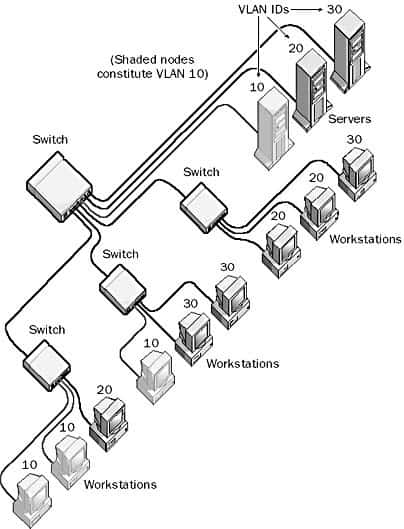Definition of Virtual LAN (VLAN) in Network Encyclopedia.
What is virtual LAN (VLAN)?
Virtual LAN, or VLAN, is a networking technology that allows networks to be segmented logically without having to be physically rewired.
How It Works
Traditional Ethernet networking devices such as hubs, bridges, and routers allow the creation of large internetworks that consist of physically separate “islands” of hosts. For example, each department in a building might have its own separate local area network (LAN) that was created using hubs, and these hubs might be interconnected to a main Ethernet switch in the main wiring room of the building. Using a switch instead of a hub as the main concentrator makes for a more efficient network because the network can be partitioned into several smaller collision domains. However, broadcasts sent by any host are still received by all hosts on the network, even if all of the hosts do not need to receive them. Also, if the organization of the departments changes, the hubs must be rewired to reflect the new topology of the network.
To overcome these problems, many Ethernet switches support virtual LAN (VLAN) technologies. By replacing all hubs with VLAN switches, the network administrator can create virtual network segments whose logical topology is independent of the physical topology of the wiring. Each station can be assigned a VLAN identification number (ID), and stations with the same VLAN ID (no matter what physical switch they are connected to) can act and function as though they are all on the same physical network segment. Broadcasts sent by one host are received only by hosts with the same VLAN ID. The assignment of VLAN IDs is done at the port level on the switches themselves and can be managed remotely using network management software. Moving a host to another department only requires the assignment of a different VLAN ID to the port on the switch to which the host is connected – no rewiring of patch cables is needed.

VLAN switches can function in different ways. They can be switched at the data-link layer (layer 2 of the Open Systems Interconnection reference model) or the network layer (layer 3), depending on the type of switching technology used. The main advantage of using VLAN technologies is that users can be grouped together according to their need for network communication, regardless of their actual physical locations. Membership in a VLAN segment (called a VLAN group) is controlled by the network management software, which allows users to be grouped according to their need for resource access and security privileges. The only disadvantage is that additional configuration is required to set up and establish the VLANs when implementing these switches.
VLAN capability support
Many high-end Cisco Systems switches and routers support VLAN capability. A protocol called Inter-Switch Link (ISL) is used to carry traffic between switches and encapsulates Ethernet frames by adding a header of 30 bytes, which includes a 2-byte VLAN ID.
VLAN techniques are also typically used in Asynchronous Transfer Mode (ATM) networks to partition the network into smaller segments for LAN emulation (LANE).
Cisco definition of Virtual LAN
Virtual LAN is a group of devices on one or more LANs that are configured (using management software) so that they can communicate as if they were attached to the same wire, when in fact they are located on a number of different LAN segments. Because VLANs are based on logical instead of physical connections, they are extremely flexible.